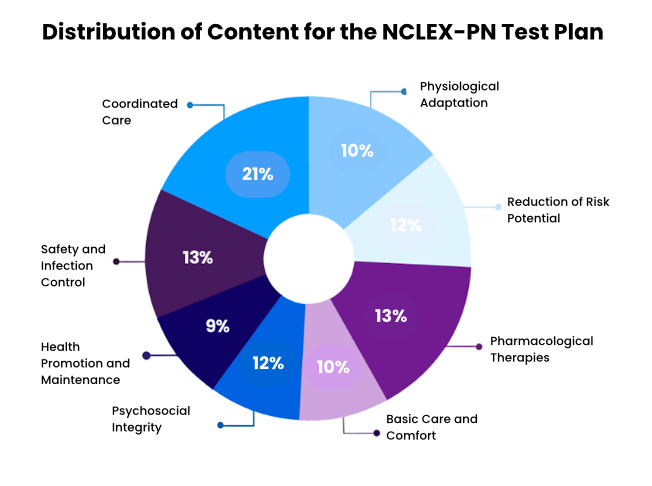
How to Pass NCLEX PN: Proven Tips for Success
Preparing to conquer the NCLEX PN exam? You’re not alone, and we’ve got your back. In the challenging world of nursing, this exam is your final hurdle before you hit the hospital floor. Let’s dive into proven strategies on how to pass NCLEX PN. From mastering content, how to study for NCLEX PN and nailing test-taking tactics, this blog has you covered. Don’t stress; success is within reach.
Let’s get started!
What is the NCLEX PN?
The NCLEX PN, or National Council Licensure Examination for Practical Nurses, is a critical milestone for aspiring practical nurses in the United States. It’s a standardized exam designed to assess the essential knowledge and skills needed to provide safe and effective nursing care.
The NCLEX PN is computer-adaptive, tailoring questions to each test-taker’s ability. It covers various nursing topics, including medical-surgical, pediatric, obstetric nursing, pharmacology, and more.
You must demonstrate competence in these areas, meeting or exceeding the passing standard to pass. Success on the NCLEX PN is crucial for licensure, enabling you to practice as a licensed practical nurse (LPN) or licensed vocational nurse (LVN). It’s a rigorous but vital step in your nursing career journey.
Format and Structure of the NCLEX PN
Computer-Adaptive Format:
The NCLEX PN is not a fixed-length exam. It adapts to your performance, beginning with a question of moderate difficulty. Depending on your response, the subsequent questions become more or less challenging. This adaptive approach allows the exam to pinpoint your ability level with precision.
Question Types:
The NCLEX PN consists of multiple-choice questions, each with four possible answer choices. However, it also includes alternate question types such as multiple-response, fill-in-the-blank, hot spots, chart/exhibit, and drag-and-drop. These variations assess your critical thinking and decision-making abilities, reflecting real-world nursing scenarios.

Content Categories:
The NCLEX PN covers various content categories, including adult medical-surgical nursing, pediatric nursing, obstetric nursing, psychiatric nursing, pharmacology, and more. The number of questions varies from 85 to 205, depending on your performance. Of these questions, 25 are pretest items that do not count toward your score.
Time Limits:
There is no specific time limit for the NCLEX PN. However, it’s essential to manage your time wisely, as you must complete the exam within six hours or when the maximum question count is reached. The test ends when the computer is confident in assessing your ability.
Understanding the format of the NCLEX PN exam is essential for effective preparation. It features a range of question types that assess your nursing knowledge and critical thinking skills to ensure your readiness for practical nursing.
9 Insider Tips for Mastering Content Review
Mastering content review for the NCLEX PN exam is a key step toward success. Here are some insider tips to help you excel:
1. Focus on High-Yield Topics: Identify the content areas that are heavily tested and prioritize those. For example, medical-surgical nursing, pharmacology, and fundamentals of nursing are frequently featured.
2. Use Reputable Resources: Invest in trusted NCLEX review books, online courses, or apps. Look for materials that are up to date and align with the latest NCLEX test plan.
3. Active Learning: Instead of passive reading, engage actively with the material. Take notes, create flashcards, and teach the content to someone else. Active learning helps retention.
4. Practice with NCLEX-Style Questions: Regularly practice with NCLEX practice questions. This helps you become familiar with the format and improves critical thinking skills.
5. Concept-Based Learning: Don’t just memorize facts; understand the underlying concepts. This makes it easier to apply your knowledge to different scenarios.
6. Break It Down: Divide your study sessions into manageable chunks. Focus on a specific content area or category each day to prevent overwhelm.
7. Use Memory Aids: Mnemonics, acronyms, and memory aids can help you remember complex information.
8. Review Weak Areas: Periodically assess your performance and focus on areas where you struggle. This targeted approach improves your overall knowledge.
9. Simulate Exam Conditions: Take full-length practice exams under natural exam conditions. This helps you get used to the time constraints and pressure of the actual test.
Mastering content review is about not just what you study but how you study. With these tips, you’ll be better prepared to tackle the NCLEX PN exam confidently.
4 Most Effective Test-Taking Strategies
When it comes to how to pass NCLEX PN exam, effective test-taking strategies can make a significant difference in your performance. Here are the four most effective strategies to excel:
1. Read the Question Carefully: Start by reading the question thoroughly, paying close attention to details. Look for keywords like “not,” “expect,” or “best.” Understanding the question is crucial.
2. Process of Elimination: If you’re unsure about an answer, use the process of elimination. Cross out the options that are clearly incorrect. This narrows down your choices and increases your chances of selecting the correct answer.
3. Prioritize and Organize: Some questions may require prioritizing actions. Use the ABCs (Airway, Breathing, Circulation) and Maslow’s Hierarchy of Needs to determine the most urgent intervention.
4. Manage Time Wisely: The NCLEX PN exam doesn’t have a set time limit for each question, but you should aim to spend around 1-2 minutes per question. If you find a question particularly challenging, flag it and come back later. Don’t dwell on a single question for too long.
Bonus Tip: Stay Calm and Manage Time: Keep your cool during the exam. If you come across a challenging question, don’t panic. Mark it for review and move on. Managing your time effectively ensures you have the opportunity to answer all questions.
By implementing these test-taking strategies, you’ll navigate the NCLEX PN exam more effectively and increase your chances of success.
Bottom Line
As you wrap up your journey to how to pass the NCLEX PN, remember that success is within reach. Your dedication and hard work will pave the way for your nursing career. With the proper guidance and preparation, you can confidently step into the exam room, knowing you’ve got this.
Consider Medic Mind’s NCLEX PN tutors. Our expert tutors, with a proven track record, can help you reach your goals. We offer a personalized approach, comprehensive study plans, and a wealth of course materials to bolster your preparation. With a 98.9% satisfaction rate and a money-back guarantee on your first lesson, you’re in good hands.
Don’t leave your future to chance. Book a free call with an NCLEX tutor now and kickstart your NCLEX preparation. Your success story begins here.
FAQs:
What is the passing score for the NCLEX PN exam, and how is it determined?
The passing score for the NCLEX PN exam is not a fixed number. It is determined by the Computerized Adaptive Testing (CAT) algorithm. The exam doesn’t have a specific passing percentage or score that all test-takers must achieve. Instead, the CAT algorithm assesses your ability level throughout the exam. To pass, you need to consistently perform above the minimum competency level based on the difficulty of the questions you answer.
How many questions are on the NCLEX PN exam, and how long does it take to complete?
The number of questions on the NCLEX PN exam varies from 85 to 205. It’s important to note that of these questions, 25 are pretest items that do not count towards your final score. The time to complete the exam is flexible, as there is no set time limit. However, you have up to six hours to finish the test, or the exam ends when the maximum question count is reached.
Is there a waiting period to retake the NCLEX PN if I don’t pass on my first attempt?
Yes, there is a waiting period to retake the NCLEX PN if you do not pass on your first try. The waiting period varies by state but is typically 45-90 days. This delay allows you to review and prepare more thoroughly for your next attempt. Check your state’s specific requirements and regulations regarding retaking the NCLEX PN.
Can I bring any reference materials or study aids into the exam room for the NCLEX PN?
No, you cannot bring any reference materials or study aids into the exam room for the NCLEX PN. The exam is designed to assess your knowledge and skills without external assistance. You will be provided with a basic calculator on the computer screen if needed, but that’s the only tool you’ll have during the test.
How long does receiving NCLEX PN exam results after completion take?
The timeframe for receiving NCLEX PN exam results varies but typically takes 2 to 4 weeks. Results are delivered through your state’s board of nursing or regulatory body. You can also check with the Pearson VUE website for official results. It’s essential to be patient and use this waiting period for additional preparation.





Was this article helpful?
Still got a question? Leave a comment